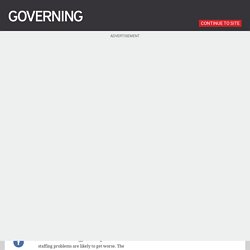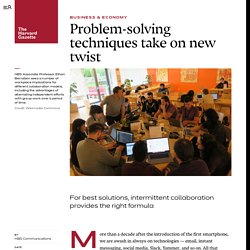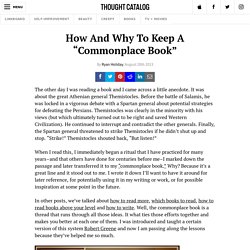

Co-Creating the Government Work Experience. All of the evidence suggests that government's staffing problems are likely to get worse.

The reasons are well documented: an aging workforce and other demographic trends, along with fiscal stresses and government's comparatively poor "brand" as an employer. The solution is obvious: developing strategies to make jobs more attractive, and doing so in close consultation with employees in a process of "co-creation. " But there has been far too little movement in that direction in the public sector. The seeds for the problem were planted a century ago when civil-service systems became deeply embedded and dictated how work and workers are managed. States started initiating civil-service reforms over 20 years ago, but far too many jurisdictions continue to rely on a management philosophy and people-management practices that are ill suited to attracting and retaining today's workers.
Workforce management practices were actually very similar across the sectors until the 1990 recession. Foundations in Design Thinking Certificate. Click the questions below for more information.

If you don't find what you’re looking for, email us at hello@ideou.com. What is the Foundations in Design Thinking Certificate? IDEO U is an online school where anyone can unlock their creative potential and solve complex problems through design thinking. There's no shortage of challenges to tackle, and we believe the world needs more creative leaders to solve these challenges. Zen leadership: Strategic Planning is Old School. As I've explained in this series, strategic planning is an old school approach that is not strategic and focuses leadership in the wrong place.

Let's look at the fundamentals of the "new school" of strategic leadership. We'll begin by replacing the "Strategic Planning Pyramid" with a "Strategic Leadership Pyramid," both illustrated below for comparative purposes. As stated in previous posts, what we've been calling "strategic planning" is really operational, not strategic; it is, in fact, project planning methodology. And this methodology is fine when it is applied to project management. In fact, it's the best approach to take when hard deadlines exist and detailed action plans are critical. Collaborate on complex problems, but only intermittently. More than a decade after the introduction of the first smartphone, we are awash in always-on technologies — email, instant messaging, social media, Slack, Yammer, and so on.

All that connectivity means we are constantly sharing ideas, knowledge, thinking, and answers. How And Why To Keep A “Commonplace Book” The other day I was reading a book and I came across a little anecdote.

It was about the great Athenian general Themistocles. How To Brainstorm Like A Googler. 6.HowToBeCreative. In the halls of state government, Michael DeAngelo experiments in extreme empowerment - Foster Blog. The Holacracy Experiment in Washington Government. Incumbents strike back. Creativity Is The New Black. Leaders agree: Creativity will be 3rd most important work skill by 2020. Creative Know How: Competencies for Student Success in a World of Change. The five competencies of Creative Know How empower students to escape old ways of doing things, solve current dilemmas, and invent new solutions.

In many respects, they are the everyday power tools in the information age. Creative Know How covers a wide range of skills, from those that have always been important (e.g., communication with others) to the ability to work in tandem with highly intelligent machines in ways that serve humanity, where even the questions to be asked are far from clear. The Fall and Rise of Strategic Planning.
Center for Creative Leadership (CCL) Adobe State of Create Global Benchmark Study. Random Oblique Strategies Online. The Library Innovation Lab at Harvard University. Universities redesign libraries for the 21st century: fewer books, more space. What it Really Means to be a Strategic Thinker. Research: For Better Brainstorming, Tell an Embarrassing Story. Executive Summary Researchers have long studied how to make brainstorming sessions more effective — for example, by setting quantity goals, instead of quality ones.

A recent study indicates that people can also be primed for more creative idea generation when they kick-off such sessions by sharing embarrassing stories, which lowers their inhibitions and, thus, improves their performance. It was Alex Osborn, a 1960s advertising executive, who coined the term brainstorming. He passionately believed in the ability of teams to generate brilliant ideas, provided they follow four rules: members should share any idea that came to mind, build on the ideas of others, avoid criticism, and, most notably, strive for quantity not quality. Civic Innovation YYC. Mental Models: The Best Way to Make Intelligent Decisions (113 Models Explained) Define and Frame Your Design Challenge by Creating Your Point Of View and Ask “How Might We” How to Kill Creativity. If the mantra for the current business climate is Innovate or die, why do so many companies seem to be choosing the latter option?

Creativity gets killed much more often than it gets supported. The problem is not that managers smother creativity intentionally—the business need for coordination and control can inadvertently undermine employees’ ability to put existing ideas together in new and useful ways. To foster an innovative workplace, you need to pay attention to employees’ expertise, creative-thinking skills, and motivation. The Problem With Best Practices. In the late ’70s, Palo Alto-based entrepreneur Debbi Fields tried to get a loan to start a cookie store.

Bankers turned her down with variations of the now-famous quote, “America likes crispy cookies, not soft, chewy cookies like you make.” If crunch was the disco-era best practice in cookie making—borne out by the popularity of Chips Ahoy! , which debuted in 1963—it didn’t stay that way. Fields eventually got her loan. Why Startup Leaders Need to Use 'Third Space Thinking'
Design Thinking Comes of Age. Executive Summary In large organizations, design is moving closer to the center of the enterprise. The Four Phases of Design Thinking. What can people in business learn from studying the ways successful designers solve problems and innovate?

On the most basic level, they can learn to question, care, connect, and commit — four of the most important things successful designers do to achieve significant breakthroughs. Having studied more than a hundred top designers in various fields over the past couple of years (while doing research for a book), I found that there were a few shared behaviors that seemed to be almost second nature to many designers. And these ingrained habits were intrinsically linked to the designer’s ability to bring original ideas into the world as successful innovations. Design Thinking Principles, Process, and Methods. The Big Principles of Design Thinking. Of the 3 Types of Skills, One Is Quickly Becoming Most Important. Research has found there are three types of skills in the world: knowledges, transferable skills and self-management skills.
Why Design Thinking Matters More in Business Than Ever. How do businesses let design inform or even lead their strategy? Switch in 16 Minutes - Heath Brothers Heath Brothers. Want to Find Fulfillment at Last? Think Like a Designer. But everything else? 10 Ideation Techniques And Methods. Want to Find Fulfillment at Last? Think Like a Designer. Design Kit. The Secret Phrase Top Innovators Use.